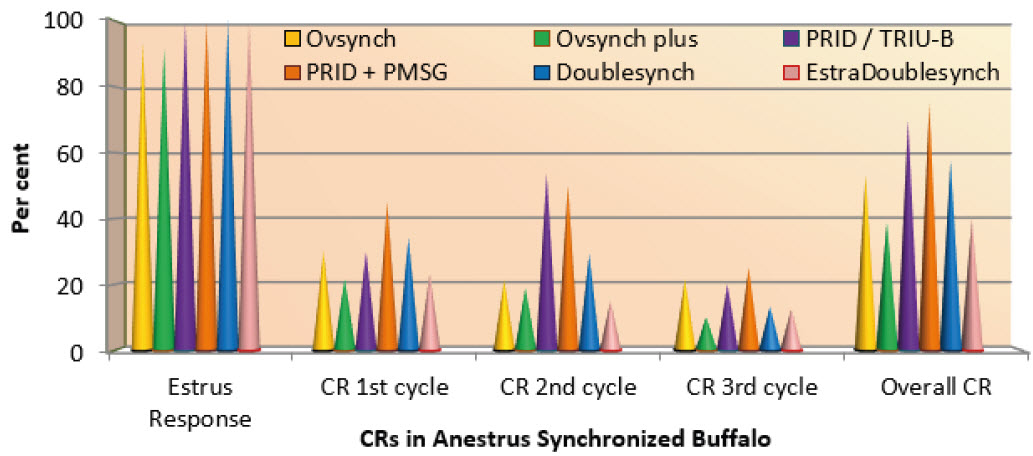Impact of different estrus induction and ovulation synchronization protocols in addressing infertility in buffaloes
Keywords:
buffaloes, Bubalus bubalis, cyclic, acyclic, synchronization protocols, estrus induction, conception rate, plasma progesteroneAbstract
The efficacy of six estrus induction/synchronization protocols, viz., Ovsynch, Ovsynch Plus, PRID/Triu-B, PRID+PMSG, Doublesynch and Estradoublesynch was compared for their estrus induction response, and conception rates at FTAI and overall of three cycles post-treatment including monitoring of plasma progesterone (P4) at different time intervals in postpartum anestrus and repeat breeding buffaloes (20 to 35 animals in each protocol) under field conditions. All infertile animals with average BCS were injected initially once with Inj. Ivermectin 100 mg s/c, Inj. organic phosphorus and Vit AD3E, 10 ml each i/m and multi-minerals 1 bolus orally for 7 days. The repeat breeders also received additional i/m Inj. of single shot Enrofloxacin 40 ml. Induction and synchronization of estrus with establishment of normal cyclicity was found in 100% animals with PRID, PRID+PMSG, Doublesynch, Estradoublesynch protocols, but the response with Ovsynch and Ovsynch Plus was 92 to 94 %. The conception rates obtained at induced estrus/FTAI in anestrus buffaloes under Ovsynch, Ovsynch Plus, PRID/Triu-B, PRID +PMSG, Doublesynch and Estradoublesynch protocols were 30.0, 21.7, 30.0, 45.0, 34.2 and 23.3%, respectively, with overall post-treatment 3 cycles’ conception rates of 53.3, 39.1, 70.0, 75.0, 57.9 and 40.0%, respectively. In repeat breeder buffaloes, the conception rates obtained at induced estrus/FTAI with Ovsynch, Ovsynch Plus, Doublesynch and Estradoublesynch protocols were 31.8, 20.0, 47.6 and 40.0%, respectively, and overall 3 cycles’ conception rates were 59.1, 46.7, 76.2 and 60.0%, respectively. Among untreated anestrus and repeat breeding control animals only 20% and 35% animals conceived over 60 to 90 days follow up. The basal level of plasma P4 in anestrus animals and higher one in repeat breeders on the day of initiation of treatment confirmed their reproductive status. The plasma P4 profile was significantly improved on day 7 to 9, i.e. just before last PGF2α injection and dropped significantly to the basal level in most of the animals in next 2 to 3 days with induced estrus. The plasma P4 was significantly higher in conceived than non-conceived animals on day 12 post-AI in all the groups suggesting anovulatory induced estrus and/or luteal insufficiency in non-conceived animals. Thus, it was concluded that the progestagen based protocols followed by Doublesynch and Ovsynch protocols were the best in anestrus animals, and doublesynch followed by Estradoublesynch and Ovsynch protocols in repeat breeders to economically improve the conception rates at induced estrus and overall of 3 cycles.
Downloads
Metrics





.png)








